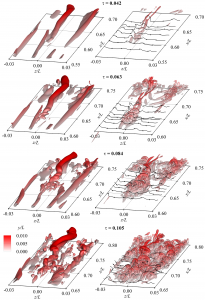Elevated free-stream turbulence accelerates the process of laminar-to-turbulent transition by the selective inclusion of low-frequency disturbances into the boundary layer. As these amplify, they form longitudinal streaks that rapidly break-down into localized regions of turbulence that resemble the turbulent spots studied here under low free-stream turbulence. The manner in which free-stream turbulence alters the spot-growth mechanisms is unclear. Because gas-turbine engine environments and turbomachinery applications involve flows with elevated free-stream turbulence levels, this question is important to answer.
Figure 1 illustrates the results of a DNS. The prevalence of longitudinal streaks in the boundary layer are evident. The break-down of the streak into a localized region of turbulence involves the production of small-scale vortical structures via an instability of the longitudinal streaks.
The results of the DNS indicate that the streak instability is due to an inviscid instability moe that is accelerated by the strong wall-directed motions induced by turbulent eddies in the free-stream. The result is that additional mechanisms are produced that accelerate the spot-growth mechanism that is already present under low free-stream turbulence levels. The turbulent spot that forms is shown in Fig. 2.

